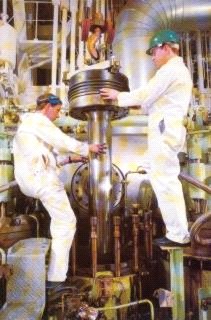Home || Diesel Engines
||Boilers||Feed Systems
||Steam Turbines ||Fuel Treatment ||Pumps ||Refrigeration ||
The main trouble to be avoided handling pistons in a marine diesel engine
Piston forms the lower part of the combustion chamber. It seals the cylinder and transmits the gas pressure to the connecting rod.
Below are the main troubles for piston that need to be avoided
i) Piston seizure; all too often followed by an explosion of the lubricating oil – air mixture in the crankcase.
ii) Cracking of piston crown and side walls, due to cyclic variation of pressure stress superimposed on stress due to temperature gradient.
iii) Burning of piston crown; this occurs mainly of large slow running engines
iv) Excessive lubricating oil consumption (trunk engines)
v) Sticking of piston rings by various deposits, formed by oxidation of lubricating oil and fuels leading to blow-past’ which is excessive can lead to piston seizure or scavenge fire (crosshead engines)
Breaking of piston rings
vi) Scuffing of piston rings and cylinder liner

Fig:Handling piston
Fuel oil cat fines causes piston ring failure
Recently there have been reported failure of Main engine Piston rings, excessive wear down of liners and Fuel pump Plunger and barrel due to build-up of Cat Fines.
Please be advised of below:
Cat fines (catalytic fines) are small, very hard particles originating from this refining process which on entering both the fuel pumps/injectors and combustion chamber of the engines can cause significant wear and damages. This recognition of the risk of damage has resulted in manufacturers reducing the maximum limit for cat fines at the engine inlet.
The latest ISO marine standards specifies levels of up to 60 ppm Al+Si in the fuel (ISO 8217, 2010). The engine manufacturers however specify a maximum amount of 15 ppm Al+Si at the engine inlet for short periods only so it is of the utmost importance that the fuel treatment plant is operated to its maximum efficiency.
Guidelines for the optimal operation of the fuel treatment plant require:
- Removal of cat fines from the fuel by setting a high temperature (minimum 98 DegC) and minimum flow through the fuel oil purifiers.
- Proper cleaning of the fuel oil service and settling tanks.
- Fuel oil separator & filter efficiency tests.
We would request to plan Cleaning of Service and settling tanks and pressure test of Steam coils at next earliest opportunity, taking all precautions in place.
Please stencil with paint on the Service and Settling tanks manhole date of last cleaning and steam coil pressure test
Summarized below more guidance for marine diesel engine piston handling safety procedure:
- Construction of 4 stroke piston
For medium and high speed engines the weight of the material becomes important to reduce the stresses on the rotating parts. The high thermal conductivity of aluminium alloys allied to its low weight makes this an ideal material. To keep thermal stresses to a reasonable level cooling pipes may be cast into prevent distortion.
More.....
- Piston oil cooling method - basic principle
The coolant used for removing and conveying the heat from a piston may be either fresh water, distilled water or lubricating oil. Water has the ability to remove more heat than lubricating oil ( specific heat of water approximately 4 and lubricating oil 2 and temperature difference 14 deg C for water and 10 deg C for lube oil)
.
More .....
-
Function of piston ring in a marine diesel engine
The efficiency of the engine depends upon the effective sealing between the piston and liners. Leakage will reduced compression pressure and power will lost. Piston rings seal the gas space by expanding outwards due to the gas pressure acting behind them. They also spread the lubricating oil up and down the cylinder liner and transfer heat to the liner walls Three to six power or compression rings are fitted to the piston, the number depending on weather the engine operates on the 2-stroke or 4-stroke cycle.
More .....
-
Requirement of piston ring
Piston forms the lower part of the combustion chamber in a marine diesel engine. It seals the cylinder and transmits the gas pressure to the connecting rod.
More .....
-
Piston designing considerations
Piston forms the lower part of the combustion chamber in a marine diesel engine. It seals the cylinder and transmits the gas pressure to the connecting rod.
More .....
Troubles of piston to be avoided
i) Piston seizure; all too often followed by an explosion of the lubricating oil – air mixture in the crankcase.
ii) Cracking of piston crown and side walls, due to cyclic variation of pressure stress superimposed on stress due to temperature gradient.
More .....
-
Detection of piston overheating
most common reasons of Piston running hot :
i) Inadequate circulation of cooling media and or supply not sufficient.
ii) Excessive deposit in cooling space (scale or carbon).
iii) Lubrication not sufficient.
More .....
Machinery Spaces.com is about working principles, construction and operation of all the machinery
items in a ship intended primarily for engineers working on board and those who working ashore . For any remarks please
Contact us
Copyright © 2010-2016 Machinery Spaces.com All rights reserved.
Terms and conditions of use
Read our privacy policy|| Home page||


